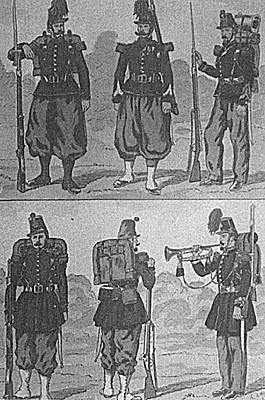 Chasseurs A Pied showing contrast between 1860 uniform (top) and 1850-59 (bottom). In 1867-68 a double breasted tunic and blue kepi trimmed yellow was adopted.
Chasseurs A Pied showing contrast between 1860 uniform (top) and 1850-59 (bottom). In 1867-68 a double breasted tunic and blue kepi trimmed yellow was adopted.
After the line infantry, the most numerous type of infantry were the Chasseurs a Pied: not to be confused as I have suggested before, with the misnamed center companies of the light infantry regiments which became line infantry in name as well in 1855. The first of the new "Chasseurs a Pied" were formed as an experimental unit drawn from the 51st of the line in 1837 to take advantage of a new cap and ball rifle designed by Col. Pontcharra and improved by Henri Delvigne and General Touvenot.
The experimental unit was termed Tirailleurs de Vincennes, and later raised to battalion strength. One eighth of the effectives, nominally carabiniers. were given an extra heavy sniper carbine. and all personnel were trained heavily in marksmanship (firing 120 live practice rounds per year compared to 60 for the line). The new unit received the patronage of the Duke of Orleans and saw action in Algeria in 1840, where its rapid and precise movements, and especially its extraordinarily accurate fire made a strong impression.
As a result, 9 new battalions were raised, and they were comprised of a staff of 7 officers, 3 men, a special section of 46 chasseurs, 8 companies of chasseurs with 3 officers and 150 men, and a company of carabiniers became the elite company. Thus the strength of 31 officers and 1,249 chasseurs was roughly double the strength of a line battalion. Later organization varied, but these special units were always significantly stronger than those of the line infantry. Ten new battalions were raised in 1854 as well as a 10 company unit of the Guard numbering 39 officers and 11,218 chasseurs. By then they had been issued the model 1846 M53 Minie rifle with saber bayonet and leaf sight with a nominal range of 1,500 meters.
The lengthy dissertation on line infantry uniforms need not be repeated for the chasseurs. Essentially the coat was dark blue, variously trimmed in yellow with white metal buttons. The trousers were of bluish iron gray similar to the capote color, and with a yellow seam in most cases. The kepi,and to some extent, the shakoes tended to be blue trimmed yellow. The pointed cuffs were dark blue with yellow trim. Officially, at least in the early years, the chasseurs were not supposed to wear epaulettes with the tunic (which, unlike the line infantry, they normally wore in battle). The epaulettes were green with yellow crescent, and almost always worn.
While officers of the line and chasseur units often had gold or silver distinction in place of other colors, those of the Chasseurs a Pied battalions were almost always silver.
Generally speaking, while these elite riflemen were more apt to fight in tunic and retained the shako in the field more often, they followed the fashion trends affecting the line - even to the point of adopting the dandified Guard Chasseur costume cut in 1860.
They reached a strength of 26 battalions by 1870 and were attached to the 1st Brigade of most infantry divisions (exceptions were often made when the brigade contained Zouaves or Turcos).
More Franco-Prussian Armies of 1870
-
Part I: Prussian Cavalry: Introduction
Part I: Prussian Cavalry: Hussars
Part I: Prussian Cavalry: Cuirassiers
Part I: Prussian Cavalry: Dragoons
Part I: Prussian Cavalry: Uhlans
Part II: French Army: Line and Light Infantry
Part II: French Army: Chasseurs a Pied Infantry
Part II: French Army: Zouave Infantry
Part II: French Army: Turco Infantry
Part II: French Army: Cavalry
Back to Table of Contents -- Courier Vol. VII #2
To Courier List of Issues
To MagWeb Master Magazine List
© Copyright 1986 by The Courier Publishing Company.
This article appears in MagWeb (Magazine Web) on the Internet World Wide Web.
Other military history articles and gaming articles are available at http://www.magweb.com